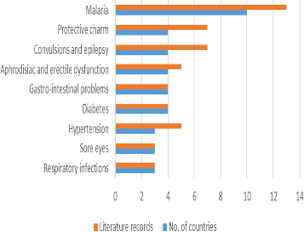Abstract
Gardenia ternifolia Schum. & Thonn. is a shrub or small tree widely used as a traditional medicine throughout its distributional range in tropical Africa. Gardenia ternifolia is widespread in tropical Africa, extending from Senegal eastwards to Ethiopia and Kenya, through the Democratic Republic of Congo (DRC) southwards to Namibia, South Africa and Mozambique. This study was aimed at providing a critical review of the medicinal uses, phytochemistry and biological activities of G. ternifolia. Documented information on the medicinal uses, phytochemistry and biological activities of G. ternifolia was collected from several online sources which included Scopus, Google Scholar, PubMed and Science Direct. Additional information was gathered from pre-electronic sources such as book chapters, books, journal articles and scientific publications obtained from the university library. This study showed that the species is widely used as an aphrodisiac and protective charm, and traditional medicine for headache, migraine, respiratory infections, sore eyes, hypertension, diabetes, gastro-intestinal problems, erectile dysfunction, malaria, convulsions and epilepsy. Phytochemical compounds identified from the species include alkaloids, anthocyanins, coumarins, flavonoids, phenols, quinones, saponins, steroids, stereoisomeric neolignans, tannins and terpenoids. Pharmacological research revealed that G. ternifolia extracts and compounds isolated from the species have antibacterial, antiviral, anti-inflammatory, antileishmanial, antioxidant, antiplasmodial, antisickling, antitheilerial, hepatotoxicity, larvicidal and cytotoxicity activities. Future research on G. ternifolia should focus on detailed phytochemical evaluations, including toxicological, in vivo and clinical studies to corroborate the traditional medical applications of the species.
Full text article
Authors

This work is licensed under a Creative Commons Attribution-NonCommercial-NoDerivatives 4.0 International License.

